Dorsally and ventrally derived oligodendrocytes have similar electrical properties but myelinate preferred tracts
- PMID: 21543611
- PMCID: PMC4227601
- DOI: 10.1523/JNEUROSCI.6474-10.2011
Dorsally and ventrally derived oligodendrocytes have similar electrical properties but myelinate preferred tracts
Abstract
In the developing spinal cord, most oligodendrocyte precursors (OLPs) arise from the ventral ventricular zone (VZ) under the influence of Sonic Hedgehog, but a minority are generated from the dorsal VZ in a Hedgehog-independent manner. In the developing forebrain too, OLPs arise from both the ventral and the dorsal VZ. It is not known whether dorsally and ventrally derived oligodendrocyte (OL) lineage cells have different properties. We generated a dual reporter mouse line to color code ventrally and dorsally derived OLPs (vOLPs and dOLPs) and their differentiated oligodendrocyte progeny (vOLs and dOLs) for functional studies. We found that ∼80% of OL lineage cells in the postnatal spinal cord and ∼20% in the corpus callosum are ventrally derived. In both spinal cord and corpus callosum, vOLPs and dOLPs had indistinguishable electrical properties, as did vOLs and dOLs. However, vOLPs and dOLPs had different migration and settling patterns. In the spinal cord, vOLPs appeared early and spread uniformly throughout the cord, whereas dOLPs arrived later and remained mainly in the dorsal and dorsolateral funiculi. During adulthood, corticospinal and rubrospinal tracts became myelinated mainly by dOLs, even though vOLs dominated these tracts during early postnatal life. Thus, dOLPs are electrically similar to vOLPs but appear to outcompete them for dorsal axons.
Figures


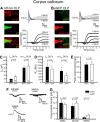
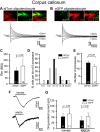
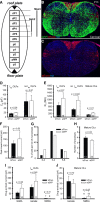
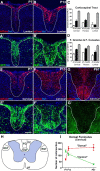
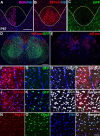
References
-
- Anderson ES. Morphology of early developing oligodendrocytes in the ventrolateral spinal cord of the chicken. J Neurocytol. 2003;32:1045–1053. - PubMed
-
- Anderson ES, Bjartmar C, Hildebrand C. Myelination of prospective large fibres in chicken ventral funiculus. J Neurocytol. 2000;29:755–764. - PubMed
-
- Bareyre FM, Kerschensteiner M, Misgeld T, Sanes JR. Transgenic labeling of the corticospinal tract for monitoring axonal responses to spinal cord injury. Nat Med. 2005;11:1355–1360. - PubMed
-
- Bjartmar C, Hildebrand C, Loinder K. Morphological heterogeneity of rat oligodendrocytes: electron microscopic studies on serial sections. Glia. 1994;11:235–244. - PubMed
Publication types
MeSH terms
Grants and funding
LinkOut - more resources
Full Text Sources
Molecular Biology Databases
